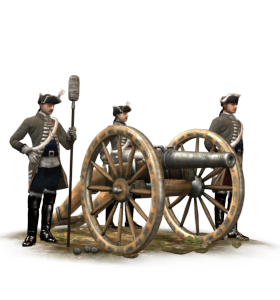24-lber Guard Artillery (ETW Unit)
 Foot artillery batteries are the core of an army on campaign: the weapons that win battles and batter down walls
Foot artillery batteries are the core of an army on campaign: the weapons that win battles and batter down walls
Overview
Despite the name, foot artillery batteries are towed by horses, not men. The artillerymen march alongside their pieces. All guns are smoothbore, and rated by the size or weight of solid projectile that they fire: a 12-pounder is so called because it hurls a cannonball weighing 12 pounds towards the enemy! It may not do so very accurately, as the casting of barrels and balls means that there is inevitably a gap (windage) between a shot and the barrel sides. This means that a cannonball rattles down the barrel when fired, leading to an inherent inaccuracy. As technology advances, other types of ammunition can be fired.
Historically, there was limited standardisation between guns, even in the same battery. Parts from one gun would not always fit a sister piece. A gunner would know the quirks of his own weapon intimately. Cunningly, the French attempted to develop a system of interchangeable components for all their guns and field equipment. Jean Baptiste Vaquette de Gribeauval (1715-1789), the inspector of artillery, tried but he wasn't entirely successful. Even after he had finished there were still more than 20 different types of wheel in use!
Details
24-lber Guard Artillery are an Artillery unit available only to France. They are a variant of the standard 24-lber foot artillery unit with various differences. The Guard artillery has significantly less firepower and range but makes up for this in accuracy and reloading skill. This makes the 24-lber Guard artillery an interesting choice in a campaign. They are able to use round shot, canister shot, and shrapnel. In addition, they can deploy some cover around them if they remain stationary on the world map for two turns or more, giving them substantial defense against missile fire; however, setting up such defensive measures robs them of their ability to redeploy and also shrinks their cone of fire by preventing them from turning. This can be a serious issue as enemy armies can simply re-position themselves and approach an entrenched position at a different angle in order to completely bypass any artillery fire.
